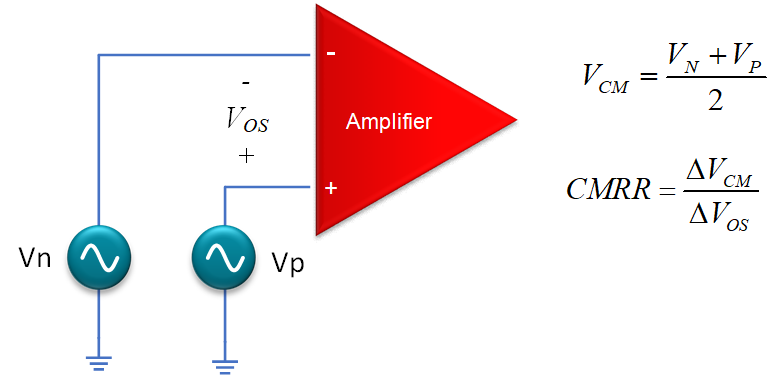SBAA499A July 2021 – April 2022 PCM3120-Q1 , PCM5120-Q1 , PCM6120-Q1 , TLV320ADC3120 , TLV320ADC5120 , TLV320ADC6120
- Trademarks
- 1 Introduction
- 2 Common-Mode Tolerance Modes
- 3 Common-Mode Rejection Performance
- 4 Input Common-Mode Distortion
- 5 Performance for TLV320ADC3120 and PCM3120-Q1
- 6 Performance for TLV320ADC5120 and PCM5120-Q1
- 7 Performance for TLV320ADC6120 and PCM6120-Q1
- 8 Summary
- 9 Related Documentation
- 10Revision History
1 Introduction
Common-mode in a differential amplifier is formally defined as the average voltage of the two input pins. Difference amplifiers are designed to amplify the differential signal and reject signals common to both input pins, such as a DC bias, noise picked up in the system, or a shifting reference. How well the amplifier does this is called the common-mode rejection ratio, or CMRR. CMRR is formally expressed as the ratio of the amplifier's differential gain to common-mode gain. In practice though, CMRR is typically measured by changing the input common-mode and observing the change in output. This measured change can be referred to the input and considered an offset voltage at the amplifier's inputs.
 Figure 1-1 Common-Mode Definition
Figure 1-1 Common-Mode DefinitionThe TLV320ADCx120 and PCMx120-Q1 family of devices has an input architecture that allows it to support a wide range of input configurations while maintaining high performance. For optimal performance the common-mode variation at the device input should be limited to less than 100 mVpp for AC coupled settings. For applications that cannot avoid large common-mode fluctuations, the TLV320ADCx120 and PCMx120-Q1 family offers multiple modes to configure the device for higher common-mode tolerance as shown in Table 2-1
Increasing the common-mode tolerance of the input does require a performance trade-off. This application note details the typical performance for each of the input modes.